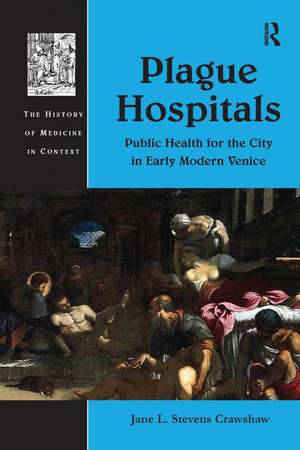Plague Hospitals: Public Health for the City in Early Modern Venice
Autor Jane L. Stevens Crawshawen Limba Engleză Paperback – 3 oct 2016
| Toate formatele și edițiile | Preț | Express |
|---|---|---|
| Paperback (1) | 488.29 lei 6-8 săpt. | |
| Taylor & Francis – 3 oct 2016 | 488.29 lei 6-8 săpt. | |
| Hardback (1) | 826.01 lei 6-8 săpt. | |
| Taylor & Francis – 28 dec 2012 | 826.01 lei 6-8 săpt. |
Preț: 488.29 lei
Nou
Puncte Express: 732
Preț estimativ în valută:
93.43€ • 97.56$ • 77.15£
93.43€ • 97.56$ • 77.15£
Carte tipărită la comandă
Livrare economică 16-30 aprilie
Preluare comenzi: 021 569.72.76
Specificații
ISBN-13: 9781138245891
ISBN-10: 1138245895
Pagini: 338
Dimensiuni: 156 x 234 x 18 mm
Greutate: 0.43 kg
Ediția:1
Editura: Taylor & Francis
Colecția Routledge
Locul publicării:Oxford, United Kingdom
ISBN-10: 1138245895
Pagini: 338
Dimensiuni: 156 x 234 x 18 mm
Greutate: 0.43 kg
Ediția:1
Editura: Taylor & Francis
Colecția Routledge
Locul publicării:Oxford, United Kingdom
Notă biografică
Jane L Stevens Crawshaw is Leverhulme Early Career Research Fellow in History at Oxford Brookes University. This is her first book.
Recenzii
'The author of this study has produced a very readable and useful work. ... This is a very good study of plague hospitals and one that thoughtfully comments on the major themes on plague studies and medical history at the end of the Middle Ages. Venetian historians will find the hospitals carefully integrated into the world they study, and more general readers will find an excellent summary work on medicine and public health in the early modern period.' Duane J. Osheim, The Historian 'In this carefully researched and engaging study, Jane L. Stevens Crawshaw offers a focused and multifaceted history of Venice’s two iconic lazaretti, or plague hospitals ... Plague Hospitals should serve as a model for how to research and write about complex and multifaceted institutions in relation to the specific social and political contexts in which they operated.' Renaissance & Reformation '... Crawshaw offers considerably more than a singular case study of Venetian lazarettos, sustaining detail of an astonishing array and depth.' The Medieval Review 'Crawshaw’s analysis raises interesting questions for the study of hospitals, epidemiology, as well as the function of charity in early modern societies. ... [her research] will hopefully reinvigorate the field by proving that there are still many materials to analyse and questions to ask about the plague and public health in early modern Europe.' Sixteenth Century Journal '... this book makes a significant contribution to the history of hospitals and the history of medicine more broadly.' Renaissance Quarterly
Cuprins
Introduction; 1: ‘From a distance it looks like a castle': First Impressions and Architectural Design; 2: The Sick-Poor; 3: ‘Abandon hope, all you who enter here': Experiences of Staff and the Patients' Daily Routine; 4: Syrups and Secrets: Treating the Plague; 5: Dying in the Lazaretti; 6: Returning to the City; Conclusion; Epilogue
Descriere
Lazaretti, or plague hospitals, took on a central role in early modern responses to epidemic disease. An in-depth study of the Venetian lazaretti in the sixteenth and seventeenth centuries, this book asks what these hospitals can tell us about early modern medicine and society.















